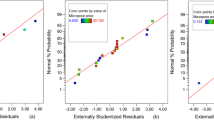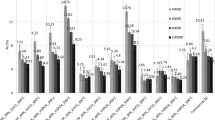Abstract
Aspergillus terreus mycelial waste produced during lipase production showed good copper biosorption capacity (160–180 mg Cu2+ biosorbed/g dry biomass). The sorption process followed fast kinetics and the absorption behaviour could be explained by a Freundlich isotherm model. The process was temperature independent and unaffected by the presence of many competing ions in a multi-ion situation. Maximum biosorption occurred between pH 4 and 5. The biomass could efficiently remove copper from mine effluents. Moreover the loaded biomass could easily be desorbed by a simple acid wash and could be reused a number of times without a decline in its biosorbing potential, thus making the process cost-effective.
Similar content being viewed by others
References
Brdy, D. & Duncan, J. R. 1993 Bioaccumulation of metal cations by Saccharomyces cerevisiae. In Biohydrometallurgical Technologies. The Minerals Metals and Materials Society, eds. Torma, A. E., Apel, M. L. & Brierly, C. L. vol. 2, pp. 711–724. USA: TMS publications. ISBN 0-87339252-3.
DeRome, L. & Gadd, G. M. 1987 Copper adsorption by Rhizopus arrhizus, Cladosporium resinae and Penicillium italicum. Applied Microbiology and Biotechnology 26, 84–90.
Gadd, G. M. 1990 Fungi and yeasts for metal accumulation. In Microbial Mineral Recovery, eds. Ehrlich, H. L. & Brierley, C. L. pp. 249–275, New York: Mc Graw-Hill. ISBN 0-07007781-9.
Gulati, R., Saxena, R. K. & Gupta, R. 1999a Fermentation waste of Aspergillus terreus: a promising copper bio-indicator. Current Science 77, 1359–1360.
Gulati R., Saxena, R. K. & Gupta R. 1999b Parametri coptimisation for Aspergillus terreus lipase production and its potential in ester synthesis. Process Biochemistry 35, 459–464.
Itoh, M., Imada, Y. & Kobayashi, T. 1975 Adsorption of metal ions on yeast cells at varied cell concentrations. Plant Cell Physiology 16, 1167–1169.
Luef, E., Prey, T. & Kubicek, C. P. 1991 Biosorption of zinc by fungal mycelial wastes. Applied Microbiology and Biotechnology 34, 688–692.
Mattuschka, B., Junghans, K. & Straube, G. 1993 Biosorption of metals by waste biomass. In Biohydrometallurgical Technologies. The Minerals, Metals and Materials Society, eds. Torma, A. E., Apel, M. L. & Brierly, C. L. vol. 2, pp. 125–132. USA: TMS publications. ISBN 0-87339252-3.
Muzzarelli, R. A. A., Tanfani, F., Scrapini, G. & Tucci, E. 1980 Removal and recovery of cupric and mercuric ions from solutions using chitosan - glucan from Aspergillus niger. Journal of Applied Biochemistry 2, 54–59.
Paknikar, K. M., Palnitkar, U. S. & Puranik, P. R. 1993 Biosorption of metals from solution by mycelial waste of Penicillium chrysogenum. In Biohydrometallurgical Technologies. The Minerals, Metals and Materials society, eds. Torma, A. E., Apel, M. L. & Brierly, C. L. vol. 2, pp 229–236. USA: TMS publications. ISBN 0-87339252-3.
Rosenberger, D. 1975 The cell wall. In The Filamentous Fungi eds. Smith, J. E. & Berry, D. R. vol. 2, pp. 328–343. London: Edward Arnold. ISBN 0-71312537-3.
Sampedro, M. A., Blanco, A., Llama, M. J. & Serr, J. L. 1995 Sorption of metals to Phormidium laminosum biomass. Biotechnology and Applied Biochemistry 22, 355–366.
Sar, P., Kazy, S. K., Asthana, R. K. & Singh, S. P. 1999 Metal adsorption and desorption by lyophilized Pseudomonas aeruginosa. International Biodeterioration and Biodegradation 44, 101–110.
Singleton, I. & Simmons, P. 1996 Factors affecting silver biosorption by an industrial strain of Saccharomyces cerevisiae. Journal of Chemical Technology and Biotechnology 65, 21–28.
Somers, E. 1963 The uptake of copper by fungal cells. Annals of Applied Biology 51, 425–437.
Townsley, C. C. & Ross, I. S. 1985 Copper uptake by Penicillium spinulosum. Microbios 44, 125–132.
Venkateswerlu, G. & Stotzky, G. 1989 Binding of metals by cell walls of Cunninghamella blakesleeana grown in the presence of copper or cobalt. Applied Microbiology and Biotechnology 31, 619–625.
Volesky, B., May, H. & Holan, Z. R. 1993 Cadmium biosorption by Saccharomyces cerevisiae. Biotechnology and Bioengineering. 41, 826–829.
White, C. & Gadd, G. M. 1990 Biosorption of radionuclides by yeast and fungal biomass. Journal of Chemical Technology and Biotechnology 49, 331–343.
Wilhelmi, B. S. & Duncan, J. K. 1995 Metal recovery from Saccharomyces cerevisiae biosorption columns. Biotechnology Letters 17, 1007–1012.
Zhou, J. L. & Kiff., R. J. 1991 The uptake of copper from solutions by immobilized fungal biomass. Journal of Chemical Technology and Biotechnology 52, 317–330.
Author information
Authors and Affiliations
Rights and permissions
About this article
Cite this article
Gulati, R., Saxena, R. & Gupta, R. Fermentation waste of Aspergillus terreus: a potential copper biosorbent. World Journal of Microbiology and Biotechnology 18, 397–401 (2002). https://doi.org/10.1023/A:1015540921432
Issue Date:
DOI: https://doi.org/10.1023/A:1015540921432




